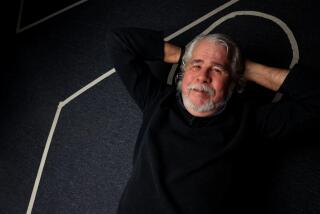Revisiting the Past, a Theater at a Time
For those who bemoan the demise of a time when going to a show meant seeing a stage act like Martin and Lewis and a movie, welcome to the Salon of the Theatres.
Tucked away among galleries and artist studios in Santa Ana’s historic Santora Building of the Arts, the Salon is a passionate expression of its creator, Joseph J. Musil, who was born in 1937 but laments he was not around in the 1920s.
“Theaters were so inspiring then,” the 68-year-old said. “They were rigged with a big stage and seemingly endless curtains that never stopped opening for shows and movies. When I die, I’m going from this world straight to the 1920s and plop myself in a theater.”
Musil, a noted theater designer whose art involves renovating movie houses, has built more than a dozen highly detailed architectural models of vintage theaters, which can be seen in his studio.
On display at the Salon of the Theatres are models of historically significant venues such as the Rialto Square Theatre in suburban Chicago featuring rococo French architecture and the now demolished Ziegfeld Theatre in New York featuring Art Deco. There also are models of famous European venues such as Copenhagen’s chinoiserie-style Tivoli Theatre. He has reproductions of tiny Victorian toy theaters, a common source of entertainment for European children in the 19th century.
The Salon’s main attraction is an Art Deco proscenium arch above a 14-foot stage. Behind the first curtain is a series of backdrops, each adorned with a distinctive scene that Musil has used in staging vaudeville shows and even an opera.
But classic American theaters -- many built in the 1920s for vaudeville, burlesque and silent movies -- are the raison d’etre of Musil’s Salon.
He credits his grandmother for his fascination with theaters. One day in 1941, when Musil was 4, she took him to the Strand Movie Palace in Long Beach to see a stage show and a movie.
“I was floored by what I saw inside. The proscenium arch. The stage curtain with a spotlight on it. The backlights along the walls. The beautiful blue chandeliers and the smell of incense. It was simply sumptuous,” Musil said.
“Most of all I remember the voice I heard telling me, ‘You must remember everything.’ Granny knew what I was going to be. She sensed it.”
Musil’s studio pays homage to an era when theater interiors were lavish and their architecture dazzling. The nostalgia is accentuated by burning incense, low-wattage mood lighting, velour drapes and a recording of a theater organ.
The theaters that have captivated Musil’s imagination were extravagant -- managers wore tuxedos, ushers braided uniforms, and the seats and carpets were plush -- yet they served up affordable entertainment.
In the early 1950s, he remembers going to the Paramount Theatre in Hollywood and seeing Dean Martin and Jerry Lewis perform onstage before settling in to watch a movie -- a Martin and Lewis film.
Forty years later, Musil was back at the Paramount, renamed the El Capitan Theatre, as the chief designer for its restoration, which was backed by the Disney Co. and Pacific Theatres.
“The world was the way I wanted it to be,” he said of his work on the El Capitan. “I was alone with my art. I didn’t have to run anything by a committee of designers.”
In their day, top-of-the-line theaters such as the El Capitan pulled back two or more curtains before audiences could view the screen.
“The old theaters had magical names like the Rialto, Majestic, Pantages, Egyptian, Grauman’s Chinese,” Musil said. “They evoked something unattainable for people, a place they could never get to. I’ve got the magic that comes from those theaters.”
But even small-town theaters, whether in Peoria, Ill., or Pomona, pulled back at least one heavy curtain as Hollywood soundtracks or organ music trumpeted the day’s feature and the projector began to flicker.
This is how America went to the movies before drive-ins were erected next to cow pastures and multiplexes in strip malls became the standard.
“You can see why I was so dazzled,” Musil said. Now “you know you’re going to get commercials before the movie, which you watch in a drab room. There’s no showmanship.”
Showmanship means something to Musil, who was drafted into the Army in the early 1960s. He was a reluctant medic before finding his niche in the military’s entertainment division. He organized a stage show called “Star Spangled Rhythm” with soldiers dressed in drag and dancing a Ziegfeld Follies skit.
Although the show came out of his love for Hollywood musicals, he said, theater restoration remains his passion.
His projects include the Crest Theatre in Westwood and the Maverick Theater in Fullerton, a playhouse intended to evoke a 1920s Hollywood speak-easy.
“I gave it a heavy Art Deco treatment. When it was completed, it’s like I walked into a soundstage at Warner Brothers in the 1930s,” Musil said.
He has his eye on the West Coast Theatre in downtown Santa Ana. His nonprofit American Museum of Theatrical Design is raising funds to buy the building, which is used as a church.
“We want to restore it and run it,” he said. “We would have vaudeville shows and use it for film festivals, showing movies from the 1920s, ‘30s, ‘40s and ‘50s.
“My art is what I’m all about. I’m all about rhinestones, velvet curtains and fringe.”
More to Read
The biggest entertainment stories
Get our big stories about Hollywood, film, television, music, arts, culture and more right in your inbox as soon as they publish.
You may occasionally receive promotional content from the Los Angeles Times.










